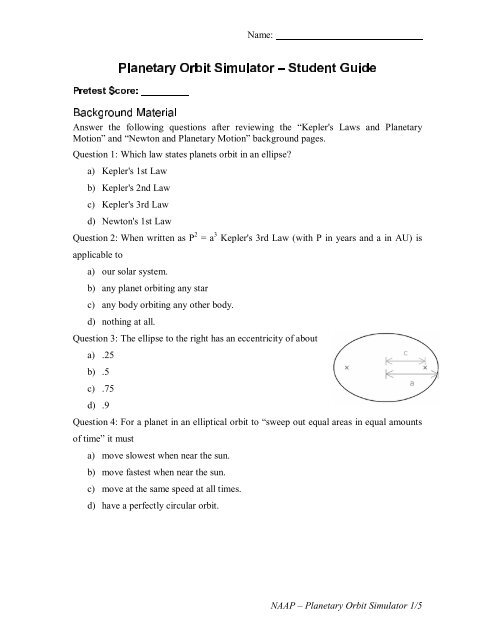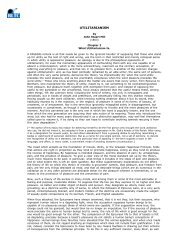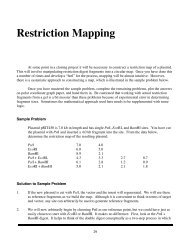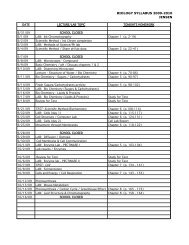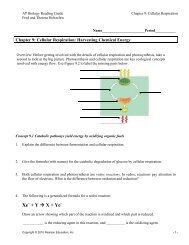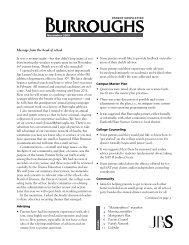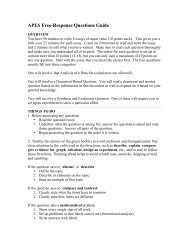Planetary Orbit Simulator Student Guide (.pdf)
Planetary Orbit Simulator Student Guide (.pdf)
Planetary Orbit Simulator Student Guide (.pdf)
You also want an ePaper? Increase the reach of your titles
YUMPU automatically turns print PDFs into web optimized ePapers that Google loves.
Answer the following questions after reviewing the “Kepler's Laws and <strong>Planetary</strong><br />
Motion” and “Newton and <strong>Planetary</strong> Motion” background pages.<br />
Material Background<br />
Name:<br />
Question 1: Which law states planets orbit in an ellipse?<br />
a) Kepler's 1st Law<br />
b) Kepler's 2nd Law<br />
c) Kepler's 3rd Law<br />
d) Newton's 1st Law<br />
Question 2: When written as P 2 = a 3 Kepler's 3rd Law (with P in years and a in AU) is<br />
applicable to<br />
<strong>Orbit</strong> <strong>Simulator</strong> – <strong>Student</strong> <strong>Guide</strong> Pretest Score: <strong>Planetary</strong><br />
a) our solar system.<br />
b) any planet orbiting any star<br />
c) any body orbiting any other body.<br />
d) nothing at all.<br />
Question 3: The ellipse to the right has an eccentricity of about<br />
a) .25<br />
b) .5<br />
c) .75<br />
d) .9<br />
Question 4: For a planet in an elliptical orbit to “sweep out equal areas in equal amounts<br />
of time” it must<br />
a) move slowest when near the sun.<br />
b) move fastest when near the sun.<br />
c) move at the same speed at all times.<br />
d) have a perfectly circular orbit.<br />
NAAP – <strong>Planetary</strong> <strong>Orbit</strong> <strong>Simulator</strong> 1/5
If you have not already done so, launch the NAAP <strong>Planetary</strong> <strong>Orbit</strong> <strong>Simulator</strong>.<br />
Law 1st Kepler’s<br />
Question 5: If a planet is twice as far from the sun at aphelion than at perihelion then the<br />
strength of the gravitational force at aphelion will be…<br />
a) will be half as much than it is at perihelion.<br />
b) twice as much than it is at perihelion.<br />
c) four times less than it is at perihelion.<br />
d) the same as at perihelion.<br />
• Open the Kepler’s 1 st Law tab if it is not already (it’s<br />
open by default).<br />
• Enable all 5 check boxes<br />
• The white dot is the “simulated planet”. One can click on<br />
it and drag it around.<br />
Tip: You can change<br />
the value of a slider<br />
by clicking on the<br />
slider bar or by<br />
entering a number in<br />
the value box.<br />
• Change the size of the orbit with the semimajor axis slider. Note how the<br />
background grid indicates change in scale while the displayed orbit size remains<br />
the same.<br />
• Change the eccentricity. Note the maximum value allowed in the simulator is not<br />
a physical limitation, but one of practical considerations.<br />
• Animate the simulated planet. Select an animation rate that is comfortable.<br />
• The planetary presets set the simulated planet’s parameters to those like our solar<br />
system’s planets. Explore these options.<br />
Question 6: When is the empty focus located at the sun, and what is the eccentricity (e)?<br />
Question 7: Draw an orbit below with non-zero eccentricity and clearly indicate a point<br />
where r 1 and r 2 are equal in value.<br />
NAAP – <strong>Planetary</strong> <strong>Orbit</strong> <strong>Simulator</strong> 2/5
• Important: Use the “clear optional features” button to remove the 1st Law<br />
features.<br />
Law 3rd and 2nd Kepler’s<br />
Question 8: Does an ellipse contain any symmetries? If so, what? Does the picture you<br />
just drew display symmetries?<br />
Question 9: How would the geometry (not the motion) of the simulated planet’s orbit<br />
change if the sun and the empty focus change places?<br />
Question 10: In the simulator, the semimajor axes of the simulated planet and the<br />
simulated solar system’s planets are all aligned – in the same direction. Do you think our<br />
actual solar system has this alignment of semimajor axes? Is it probable? Does Kepler’s<br />
1st Law address this issue?<br />
• Open the Kepler's 2nd Law tab.<br />
• Press the “start sweeping” button. Adjust the semimajor axis and animation<br />
rate so that the planet moves at a reasonable speed.<br />
• Adjust the size of the sweep using the “adjust size” slider.<br />
• Click and drag the sweep segment around. Note how the shape of the sweep<br />
segment changes, but the area does not.<br />
• Add more sweeps. Erase all sweeps with the “erase sweeps” button.<br />
• The “sweep continuously” check box will cause sweeps to be created<br />
continuously when sweeping. Test this option.<br />
• Before answering the following questions:<br />
o Erase all sweeps and put 2 or 3 on the screen<br />
NAAP – <strong>Planetary</strong> <strong>Orbit</strong> <strong>Simulator</strong> 3/5
• Important: Use the “clear optional features” button to remove other features.<br />
Features Newtonian<br />
o Open Kepler's 3rd Law tab<br />
o Change the semimajor axis to something about Mars or Jupiter<br />
o Change the eccentricity to a non-zero – somewhere around 0.5<br />
Question 11: Where (or when) is the sweep segment the “skinniest”?<br />
Question 12: What eccentricity in the simulator gives the greatest variation of sweep<br />
segment shape?<br />
Question 13: If the sweep segments were measured from the empty focus and not from<br />
the sun, would Kepler's 2nd Law still be valid? Explain your reasoning.<br />
Question 14: Does changing the eccentricity in the simulator change the period of the<br />
planet? Why not?<br />
Question 15: Halley’s comet has a semimajor axis of about 18.5 AU and an eccentricity<br />
of about 0.97. How does Kepler’s 2 nd Law explain why we can only see the comet every<br />
76 or so years?<br />
• Open the Newtonian features tab.<br />
• Click both show vector boxes. Observer the direction and length of the arrows.<br />
The length is linked to the graph on the Newtonian features tab.<br />
• Explore different planetary presets. Note how their eccentricity and various<br />
orbital sizes and effects the variation of acceleration and velocity in their orbits.<br />
• Adjust the semimajor axis and animation rate so that the planet moves at a<br />
comfortable speed.<br />
NAAP – <strong>Planetary</strong> <strong>Orbit</strong> <strong>Simulator</strong> 4/5
• Set the simulator to a non-zero eccentricity – somewhere around 0.5.<br />
Question 16: The acceleration vector is always pointing towards what object in the<br />
simulator?<br />
Question 17: When is the planet speeding up and when is it slowing down?<br />
Question 18: When the planet is speeding up, does the acceleration arrow angle more<br />
towards the velocity arrow or more away from the velocity arrow?<br />
Question 19: At what point(s) do the acceleration and velocity vectors make a right angle<br />
with respect to each other for an orbit with non-zero eccentricity?<br />
Question 20: Using the presets, which planet has a greater (relative) variation in<br />
acceleration, Mars or Venus? Why?<br />
Posttest Score:<br />
NAAP – <strong>Planetary</strong> <strong>Orbit</strong> <strong>Simulator</strong> 5/5


